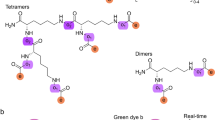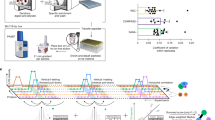Abstract
Protein microarrays provide an efficient way to identify and quantify protein–protein interactions in high throughput. One drawback of this technique is that proteins show a broad range of physicochemical properties and are often difficult to produce recombinantly. To circumvent these problems, we have focused on families of protein interaction domains. Here we provide protocols for constructing microarrays of protein interaction domains in individual wells of 96-well microtiter plates, and for quantifying domain–peptide interactions in high throughput using fluorescently labeled synthetic peptides. As specific examples, we will describe the construction of microarrays of virtually every human Src homology 2 (SH2) and phosphotyrosine binding (PTB) domain, as well as microarrays of mouse PDZ domains, all produced recombinantly in Escherichia coli. For domains that mediate high-affinity interactions, such as SH2 and PTB domains, equilibrium dissociation constants (KDs) for their peptide ligands can be measured directly on arrays by obtaining saturation binding curves. For weaker binding domains, such as PDZ domains, arrays are best used to identify candidate interactions, which are then retested and quantified by fluorescence polarization. Overall, protein domain microarrays provide the ability to rapidly identify and quantify protein–ligand interactions with minimal sample consumption. Because entire domain families can be interrogated simultaneously, they provide a powerful way to assess binding selectivity on a proteome-wide scale and provide an unbiased perspective on the connectivity of protein–protein interaction networks.
This is a preview of subscription content, access via your institution
Access options
Subscribe to this journal
Receive 12 print issues and online access
$259.00 per year
only $21.58 per issue
Buy this article
- Purchase on Springer Link
- Instant access to full article PDF
Prices may be subject to local taxes which are calculated during checkout




Similar content being viewed by others
References
Fields, S. & Song, O. A novel genetic system to detect protein–protein interactions. Nature 340, 245–246 (1989).
Chien, C.T., Bartel, P.L., Sternglanz, R. & Fields, S. The 2-hybrid system—a method to identify and clone genes for proteins that interact with a protein of interest. Proc. Natl. Acad. Sci. USA 88, 9578–9582 (1991).
Johnsson, N. & Varshavsky, A. Split ubiquitin as a sensor of protein interactions in vivo. Proc. Natl. Acad. Sci. USA 91, 10340–10344 (1994).
Gavin, A.C. et al. Functional organization of the yeast proteome by systematic analysis of protein complexes. Nature 415, 141–147 (2002).
Ho, Y. et al. Systematic identification of protein complexes in Saccharomyces cerevisiae by mass spectrometry. Nature 415, 180–183 (2002).
Smith, G.P. Filamentous fusion phage—novel expression vectors that display cloned antigens on the virion surface. Science 228, 1315–1317 (1985).
Songyang, Z. et al. SH2 domains recognize specific phosphopeptide sequences. Cell 72, 767–778 (1993).
MacBeath, G. & Schreiber, S.L. Printing proteins as microarrays for high-throughput function determination. Science 289, 1760–1763 (2000).
Ito, T. et al. A comprehensive two-hybrid analysis to explore the yeast protein interactome. Proc. Natl. Acad. Sci. USA 98, 4569–4574 (2001).
Uetz, P. et al. A comprehensive analysis of protein–protein interactions in Saccharomyces cerevisiae. Nature 403, 623–627 (2000).
Giot, L. et al. A protein interaction map of Drosophila melanogaster. Science 302, 1727–1736 (2003).
Li, S. et al. A map of the interactome network of the metazoan C. elegans. Science 303, 540–543 (2004).
Rual, J.F. et al. Towards a proteome-scale map of the human protein–protein interaction network. Nature 437, 1173–1178 (2005).
Stelzl, U. et al. A human protein–protein interaction network: a resource for annotating the proteome. Cell 122, 957–968 (2005).
Tarassov, K. et al. An in vivo map of the yeast protein interactome. Science 320, 1465–1470 (2008).
Gavin, A.C. et al. Proteome survey reveals modularity of the yeast cell machinery. Nature 440, 631–636 (2006).
Fuh, G. et al. Analysis of PDZ domain–ligand interactions using carboxyl-terminal phage display. J. Biol. Chem. 275, 21486–21491 (2000).
Tonikian, R., Zhang, Y., Boone, C. & Sidhu, S.S. Identifying specificity profiles for peptide recognition modules from phage-displayed peptide libraries. Nat. Protoc. 2, 1368–1386 (2007).
Tonikian, R. et al. A specificity map for the PDZ domain family. PLoS Biol. 6, e239 (2008).
Zhang, Y. et al. Convergent and divergent ligand specificity among PDZ domains of the LAP and zonula occludens (ZO) families. J. Biol. Chem. 281, 22299–22311 (2006).
Songyang, Z. et al. Recognition of unique carboxyl-terminal motifs by distinct PDZ domains. Science 275, 73–77 (1997).
Aloy, P. & Russell, R.B. Potential artefacts in protein-interaction networks. FEBS Lett. 530, 253–254 (2002).
Bader, J.S., Chaudhuri, A., Rothberg, J.M. & Chant, J. Gaining confidence in high-throughput protein interaction networks. Nat. Biotechnol. 22, 78–85 (2004).
Deane, C.M., Salwinski, L., Xenarios, I. & Eisenberg, D. Protein interactions: two methods for assessment of the reliability of high throughput observations. Mol. Cell. Proteomics 1, 349–356 (2002).
Phizicky, E., Bastiaens, P.I., Zhu, H., Snyder, M. & Fields, S. Protein analysis on a proteomic scale. Nature 422, 208–215 (2003).
Popescu, S.C. et al. MAPK target networks in Arabidopsis thaliana revealed using functional protein microarrays. Genes Dev. 23, 80–92 (2009).
Ptacek, J. et al. Global analysis of protein phosphorylation in yeast. Nature 438, 679–684 (2005).
Zhu, H. et al. Global analysis of protein activities using proteome chips. Science 293, 2101–2105 (2001).
He, M. & Taussig, M.J. Single step generation of protein arrays from DNA by cell-free expression and in situ immobilisation (PISA method). Nucleic. Acids Res. 29, e73 (2001).
Ramachandran, N. et al. Self-assembling protein microarrays. Science 305, 86–90 (2004).
Jones, R.B., Gordus, A., Krall, J.A. & MacBeath, G. A quantitative protein interaction network for the ErbB receptors using protein microarrays. Nature 439, 168–174 (2006).
Gordus, A. & MacBeath, G. Circumventing the problems caused by protein diversity in microarrays: implications for protein interaction networks. J. Am. Chem. Soc. 128, 13668–13669 (2006).
Kaushansky, A. et al. System-wide investigation of ErbB4 reveals 19 sites of Tyr phosphorylation that are unusually selective in their recruitment properties. Chem. Biol. 15, 808–817 (2008).
Kaushansky, A., Gordus, A., Chang, B., Rush, J. & MacBeath, G. A quantitative study of the recruitment potential of all intracellular tyrosine residues on EGFR, FGFR1 and IGF1R. Mol. Biosyst. 4, 643–653 (2008).
Gordus, A. et al. Linear combinations of docking affinities explain quantitative differences in RTK signaling. Mol. Syst. Biol. 5, 235 (2009).
Stiffler, M.A. et al. PDZ domain binding selectivity is optimized across the mouse proteome. Science 317, 364–369 (2007).
Stiffler, M.A., Grantcharova, V.P., Sevecka, M. & MacBeath, G. Uncovering quantitative protein interaction networks for mouse PDZ domains using protein microarrays. J. Am. Chem. Soc. 128, 5913–5922 (2006).
Chen, J.R., Chang, B.H., Allen, J.E., Stiffler, M.A. & MacBeath, G. Predicting PDZ domain–peptide interactions from primary sequences. Nat. Biotechnol. 26, 1041–1045 (2008).
Pawson, T. & Nash, P. Assembly of cell regulatory systems through protein interaction domains. Science 300, 445–452 (2003).
Yan, K.S., Kuti, M. & Zhou, M.M. PTB or not PTB—that is the question. FEBS Lett. 513, 67–70 (2002).
Boutell, J.M., Hart, D.J., Godber, B.L., Kozlowski, R.Z. & Blackburn, J.M. Functional protein microarrays for parallel characterisation of p53 mutants. Proteomics 4, 1950–1958 (2004).
von Mering, C. et al. Comparative assessment of large-scale data sets of protein–protein interactions. Nature 417, 399–403 (2002).
Edelhock, H. Spectroscopic determination of tryptophan and tyrosine in proteins. Biochemistry 6, 1948–1954 (1967).
Barbulovic-Nad, I. et al. Bio-microarray fabrication techniques—a review. Crit. Rev. Biotechnol. 26, 237–259 (2006).
George, R.A. The printing process: tips on tips. Methods Enzymol. 410, 121–135 (2006).
Schultz, J., Milpetz, F., Bork, P. & Ponting, C.P. SMART, a simple modular architecture research tool: identification of signaling domains. Proc. Natl. Acad. Sci. USA 95, 5857–5864 (1998).
Acknowledgements
We thank J.-R. Chen, G. Koytiger and M. Sevecka for helpful contributions to these protocols, particularly in regards to data processing and analysis. This work was supported by awards from the W.M. Keck Foundation, the Arnold and Mabel Beckman Foundation, and the Camille and Henry Dreyfus Foundation, and by grants from the National Institutes of Health (1 RO1 GM072872 and 1 R33 CA128726). A.K. was supported in part by the National Institutes of Health Molecular, Cellular and Chemical Biology Training grant (5 T32 GM07598) and A.G. was the recipient of an NSF Graduate Research Fellowship.
Author information
Authors and Affiliations
Contributions
A.K., J.E.A. and G.M. wrote the article. A.G. developed initial protocols for printing and probing microarrays of SH2 and PTB domains. A.K. contributed to the further development of these protocols. M.A.S. developed initial protocols for quantifying PDZ domain–peptide interactions using fluorescence polarization. J.E.A. developed peptide synthesis protocols and contributed to the development of FP assays. E.S.K. assisted in the development of FP assays and to the processing of SH2/PTB domain microarray data. B.H.C. developed peptide purification protocols and contributed to the development of FP protocols.
Corresponding author
Ethics declarations
Competing interests
Gavin MacBeath is an advisor for and stockholder in Merrimack Pharmaceuticals, Inc., Makoto Life Sciences, Inc., and Aushon BioSystems, Inc.
Rights and permissions
About this article
Cite this article
Kaushansky, A., Allen, J., Gordus, A. et al. Quantifying protein–protein interactions in high throughput using protein domain microarrays. Nat Protoc 5, 773–790 (2010). https://doi.org/10.1038/nprot.2010.36
Published:
Issue Date:
DOI: https://doi.org/10.1038/nprot.2010.36
This article is cited by
-
Efficient link prediction in the protein–protein interaction network using topological information in a generative adversarial network machine learning model
BMC Bioinformatics (2022)
-
Predicting ligand-dependent tumors from multi-dimensional signaling features
npj Systems Biology and Applications (2017)
-
High-throughput methods for identification of protein-protein interactions involving short linear motifs
Cell Communication and Signaling (2015)
-
Detection of Target Proteins by Fluorescence Anisotropy
Journal of Fluorescence (2013)
Comments
By submitting a comment you agree to abide by our Terms and Community Guidelines. If you find something abusive or that does not comply with our terms or guidelines please flag it as inappropriate.



